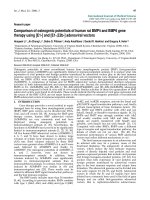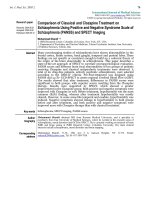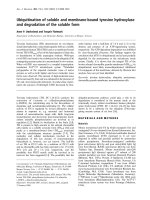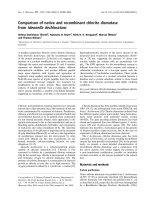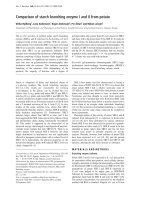Báo cáo y học: "Comparison of raw and processed Radix Polygoni Multiflori (Heshouwu) by high performance liquid chromatography and mass spectrometry" pptx
Bạn đang xem bản rút gọn của tài liệu. Xem và tải ngay bản đầy đủ của tài liệu tại đây (1.1 MB, 9 trang )
RESEARC H Open Access
Comparison of raw and processed Radix Polygoni
Multiflori (Heshouwu) by high performance liquid
chromatography and mass spectrometry
Zhitao Liang, Hubiao Chen, Zhiling Yu, Zhongzhen Zhao
*
Abstract
Background: Radix Polygoni Multiflori is the dried root tuber of Polygonum multiflorum Thunb. (Fam. Polygonaceae).
According to Chinese medicine theory, raw (R-RPM) and processed (P-RPM) Radix Polygoni Multiflori possess
different properties. The present study investigates the differences in chemistry between raw and processed Radix
Polygoni Multiflori.
Methods: Five pairs of R-RPM and P-RPM as well as 15 commercial decoction pieces were analyzed with high
performance liquid chromatography (HPLC) and mass spectrometry (MS).
Results: Two anthraquinones, namely emodin-8-O-(6′-O-malonyl)-glucoside and physcion-8-O-(6′ -O -malonyl)-
glucoside disappeared or decreased significantly and 2,3,5,4′-tetrahydroxystilbene-2-O-b-D-glucopyranoside,
emodin-8-O-b-D-glucopyranoside and physcion-8- O-b-D-glucopyranoside decreased after the R-RPM samples being
processed. On the other hand, the contents of emodin and physcion generally increased after proces sing.
Conclusion: The present study indicates that processing Radix Polygoni Multiflori may change the contents and
types of chemicals in it. These changes are probab ly responsible for the various pharmacological effects of R-RPM
and P-RPM as well as hepatotoxicity.
Background
Proper pharmaceutical processing may reduce toxicity
or side eff ects, potentiate the beneficial effects, change
the pharmacological properties, preserve active constitu-
ents, facilitate administration, improve flavor or correct
unpleasant taste and increase purity of Chinese materia
medica [1-4]. In China, the processing methods for
Radix Polygoni Multiflori have been practiced since the
Tang dynasty [5] and are documented in the Chinese
pharmacopoeia [6]. Radix Polygoni Multiflori
(Heshouwu) is t he dried root tuber of Polygonum multi -
florum Thunb. (Fam. Polygonaceae) [6]. According to
Chinese medicine theory, raw Radix Polygoni Multiflori
(R-RPM) counteracts toxicity, cures carbuncles and
relaxes the bowels whereas processed Radix Polygoni
Multiflori (P-RPM) replenishes the liver and kidney with
vital essence and blood, blackens the hair and strength-
ens the tendons and bones.
R-RPM and P-RPM possess different pharmacological
properties. While P-RPM (steamed with black bean
juice) enhanced immune activities and anti-immuno-
suppression, R-RPM did not [7]. R-RPM was purgative
whereas P-RPM was not [8] , probably due to lower con-
tent of anthraquin ones glycosides in P-RPM. R-RPM
inhibited triglyceride accumulation induced by carbon
tetrachloride (CCl
4
), cortisone acetate and thioacetamide
(TAA) in the mouse liver and P-RPM lowered the tri-
glyceride accumulation induced by cortisone acetate;
both R-RPM and P-RPM reduced liver enlargement
caused by CCl
4
[9].
It is important to differentiate R-RPM from P-RPM
because Radix Polygoni Multiflori was linked to hepato-
toxicity and other liver conditions [10-15]. Over-the-
counter preparation s such as Shouwu pian and Shenmin
(both containing Radix Polygoni Multiflori) may cause
acute hepatitis. A recent study found that, Radix Poly-
goni Multiflori was the hepatotoxic c omponent that
* Correspondence:
School of Chinese Medicine, Hong Kong Baptist University, Kowloon,
Hong Kong SAR, China
Liang et al . Chinese Medicine 2010, 5:29
/>© 2010 Liang et al; licensee BioMed Central Ltd. This is an Open Access article distributed und er the terms of the Cre ative Co mmons
Attribution Lic ense ( which permits unrestricted use, distribution, and reproduction in
any medium, provided the original work is properly cited.
caused acute hepatitis [16]. There were other hepato-
toxic cases related to Radix Polygoni Multiflori [17-20].
R-RPM did not induce liver injury [21] but P-RPM
could damage rat’ s liver after long-term use of high
dosages (40 g/kg/day) by intragastric administration.
However,notoxicorsideeffectswerefoundwhen
P-RPM was used at the dosage of 22 g/kg/day which is
10 times of the normal intake for adult per day [22,23].
Radix Polygoni Multiflori contains anthraquinones
(emodin, chrysophanol, physcion, citreorosein, chryso-
phanol-8-O-b-D- glucopyranoside, physcion-8-O-b- D-
glucopyranoside, emodin-8-O-b-D- glucopyranoside,
emodin-1, 6-dimethy lether , questin, questinol, 2-a cetyle-
modin, 2-methoxy-6-acetyl-7-methyljuglone, emodin-8-
O-(6′-O-malonyl)-glucoside) [24-26]; stilbene glucosides
(2,3,5,4 ′-tetrahydroxystilbene-2-O-b-D-glucopyranoside,
2,3,5,4′- tetrahydroxystilbene-2, 3-O-b-D-glucopyrano-
side [27]) and flavonoids (tricin [25], quercetin-3-O-
galactoside, quercetin-3-O-arabinoside [28]), as well as
gallic acid, catechin [29], torachrysone-8-O-b-D-g luco-
pyranoside [27], N-transferu loyl tyramine, N-transferu-
loyl-3-methyldopamine [25] and 1,3-dihydroxy-6,7
-dimethylxanthone -1-O-b-D-glucopyranoside [27].
ThereweremorefreeanthraquinonesinP-RPMthan
that in R-RPM. However, anthraquinone glycosides and
stilbene glucoside were more abundant in R-RPM than
P-RPM [30]. P-RPM contains components not present
in R-RPM, namely 2,3-dihydro-3,5-dihydroxy-6-methyl-4
(H)-pyran-4-one and 5-hydroxymethyl furfural; P-RPM
contains less amino acids and monosaccharides and has
a lower pH value than R-RPM [31].
In recent years, high performance liquid chromatogra-
phy (HPLC) and gas chromatography (GC) have been
employed to determine the level of anthraquinones in
Radix Polygoni Multiflori [32,33].
Using HPLC-DAD and mass spectrometry, the present
study compares five pairs of raw and processed Radix
Polygoni Multiflori as well as some samples from com-
mercially available decoctions.
Methods
Plants
Five samples o f R-RPM and 15 samples of commercial
decoction pieces of Radix Polygoni Multiflori were col-
lected from cultivation areas or purchased from pharma-
cies in China (Table 1). The R-RPM was softened by
water and then steamed in an autoclave (HV-85, Hir-
ayama, Japan) for four hours at 121☐ and under 2.03
pounds per sq uare inch (psi), according to the processing
methods documented in the Chinese pharmacopoeia [6].
Table 1 A list of tested samples from China
Sample name No. Source Collection
time
Raw Radix Polygoni Multiflori 1 Daqiao Village, Deqing County, Guangdong, China;
cultivated
2008. 05. 30
2 Dengyun Village, Deqing County, Guangdong, China;
cultivated
2008. 05. 30
3 Duimian Village, Deqing County, Guangdong, China;
cultivated
2008. 05. 30
4 Chengdu, Sichuan, China; market 2008. 09. 25
5 Guangzhou, Guangdong, China; market 2008. 12. 10
Commercial Radix Polygoni Multiflori from Deqing County,
Guangdong, China
1 Wild 2007. 12. 25
2 Half wild for 5-6 years 2007. 12. 25
3 Cultivated in the mountain for 5-6 years 2007. 12. 25
4 Cultivated in the normal soil for 3-4 years 2007. 12. 25
5 Cultivated in the mountain 2007. 12. 25
6 Cultivated in the normal soil for one year 2007. 12. 25
7 Cultivated in the normal soil for one year 2007. 12. 25
8 Cultivated in the normal soil for one year 2007. 12. 25
Commercial processed Radix Polygoni Multiflori from Chinese herbal
shops
1 Hong Kong, China; market 2007. 12. 05
2 Hong Kong, China; market 2007. 12. 05
3 Hong Kong, China; market 2007. 12. 05
4 Hong Kong, China; market 2007. 12. 05
5 Shenzhen, Guangdong, China; market 2007. 12. 05
6 Shenzhen, Guangdong, China; market 2007. 12. 05
7 Guangzhou, Guangdong, China; market 2008. 12. 10
Liang et al . Chinese Medicine 2010, 5:29
/>Page 2 of 9
All the herbs were authenticated macroscopicall y by Prof
Zhongzhen Zhao. The corresponding voucher specimens
were deposited in the Bank of China (Hong Kong) Chi-
nese Me dici nes Centre of Hong Kong Ba ptist University,
Hong Kong SAR, China.
Instrumentation
A CREST 1875HTAG ultrasonic processor ( CREST,
USA) was used for sample extraction. HPLC fingerprint-
ing analysis was performed on an Agilent1100 series LC
system consisting of a G1311A Quart pump, a G1322A
degasser, a G1315A photodiode array detector (DAD)
and a G1313A automatic liquid sampler (ALS). A
MicroQTOF system with an electrospray ionization
source (Bruker Daltonics, Germany) was used for mass
spectrometric analysis. Separation was performed at
room temperature on an Alltima C
18
analytical column
(250 mm × 4.6 mm, 5 μm, Alltech Associates, USA)
coupled with a C
18
guard column (7.5 mm × 4.6 mm, 5
μm, Alltech Associates, USA) that was eluted with acet-
onitrile (containing 0.5% acetic acid)/water (containing
0.5% acetic acid) at a flow rate of 1 mL/min by a dis-
continuous gradient in which acetonitrile was adjusted
to 10%, 35% and 100%, at 0, 45 and 65 minutes respec-
tively. Detection was performed at 280 nm. The mass
spectra were detected in positive mode. The flow rate of
drying gas (N
2
) and nebulizing gas were 4 L/min and
0.4 L/min respectively. Ion source temperature was set
at 200☐ and the scan range was 200-1500 amu.
Chemicals and reagents
HPLC-grade acetonitrile (Labscan, T hailand) and deio-
nized water obtained from a Milli-Q water system (Milli-
pore, USA) were used for preparation of the mobile
phase. Analytical grade methanol (Labscan, Thailand)
was used for preparation of standards and sample extrac-
tion. Reference compounds of 2, 3,5,4′-tetrahydroxystil-
bene-2-O-b-D- glucopyranoside (THSG, 1), emodin (2)
and physcion (3) (purities >97%) were purchased from
the National Institute for the Control of Pharmaceutical
and Biological Products, China (Batch numbers 110844-
200505, 110756-200110 and 110758-200610 respectively).
Preparation of standard and sample solutions
The three reference compou nds (1-3) were accurately
weighed and dissolved in methanol to produce standard
Figure 1 HPLC chromatograms of raw and process ed Radix Polygoni Multiflori from Dengyun Village, Deqing County, Guangdong,
China (refer to Table 2 for peak numbering).
Liang et al . Chinese Medicine 2010, 5:29
/>Page 3 of 9
Figure 2 HPLC fingerprints of R-RPM and its corresponding P-RPM from various sources in China.
Table 2 MS data of major identified/unknown compounds in the HPLC chromatograms of R-RPM
Peak No. Mass Spectra Identified compounds (tentative names)
1 291.1 ([M+H]
+
); 581.2 ([2M+H]
+
) Catechin
2 407.1 ([M+H]
+
) 2,3,5,4’-tetrahydroxystilbene-2-O-b-D- glucopyranoside
3 257.1 ([M+H-glu]
+
); 419.1 ([M+H]
+
) 1,3-dihydroxy-6,7-dimethylxanthone-1- O-b-D- glucopyranoside
4 247.1 ([M+H-glu]
+
); 409.1 ([M+H]
+
); 431.1 ([M+Na]
+
) Torachrysone-8- O-b-D- glucopyranoside
5 271.1 ([M+H-glu]
+
); 455.1 ([M+Na]
+
) Emodin-8-O-b-D-glucopyranoside
6 271.1 ([M+H-malonyl-glu]
+
); 541.1 ([M+Na]
+
); 1059.2 ([2M+K]
+
) Emodin-8-(6’-O-malonyl)-glucoside
7 285.1 ([M+H-glu]
+
); 469.1 ([M+Na]
+
) Physcion-8-O-b-D- glucopyranoside
8 285.1 ([M+H-malonyl-glu]
+
); 555.1 ([M+Na]
+
); 1103.2 ([2M+K]
+
) Physcion-8-O-(6’-O-malonyl)-glucoside
9 271.1 ([M+H]
+
) Emodin
10 285.1 ([M+H]
+
) Physcion
Liang et al . Chinese Medicine 2010, 5:29
/>Page 4 of 9
Figure 3 Chemical structures of the identified compounds in the HPLC chromatograms Peak 1: catechin; Peak 2: 2,3,5,4’ -
tetrahydroxystilbene-2-O-b-D- glucopyranoside; Peak 3: 1,3-dihydroxy-6,7-dimethylxanthone-1-O-b-D-glucopyranoside; Peak 4:
torachrysone-8-O-b-D-glucopyranoside; Peak 5: emodin-8-O-b-D- glucopyranoside; Peak 6: emodin-8-(6’-O-malonyl)-glucoside; Peak 7:
physcion-8-O-b-D- glucopyranoside; Peak 8: physcion-8-O-(6’-O- malonyl)-glucoside; Peak 9: emodin; Peak 10: physcion.
Liang et al . Chinese Medicine 2010, 5:29
/>Page 5 of 9
solutions. 0.5 g powdered sample was refluxed w ith
25 ml methano l for 90 minutes. Then the supernatant
was filtered through a 0.45 μm membrane and 10 μl
samples were analyzed with HPLC and LC-MS.
Method validation
Reproducibility and repeatability of the method were
determined with five injections of one sample solution
and five replicates of one solid sample prepared accord-
ing to the method. Stability of the method was deter-
mined with the sample solution after 0, 2, 4, 8 and
12 hours in a single day and for further one and two days.
Data processing
ChromatographicdatawereanalyzedwithComputer
Aided Similarity Evaluation System software (Central
South University, China) [34]. The software synchronized
the chromatographic peaks and calculated the correlation
coefficients for similarity of the chromatograms.
Results and discussion
Optimization and validation of HPLC conditions
To optimize the elution conditions, we investigated the
mobile phase of acetonitrile (containing 0.5% acetic
acid)-water (containing 0.5% acetic acid) with various
gradients and the optima l acetonitrile-water sy stem was
determined to have acetonitrile adjusted to 10%, 35%,
and 100%, at 0, 45 and 65 min, respectively.
The limits of detection, evaluated by a signal-to-
noise ratio of about 3:1 for the standard solution,
were 0.575 μg/ml, 0.343 μg/ml and 0.523 μg/ml for
compounds 1, 2 and 3 respectively. The correlation
coefficients were 0.973 ± 0.021 (n =5)at280nm
detection wavelength for reproducibility and 0.968 ±
0.022 (n = 5) for repeatability test. In stability testing,
the correlation coefficients were 0.972 ± 0.034 (n =5)
over a period of 12 hours and 0.984 ± 0.015 (n =7)
over a period of three days. These results indicated
that the conditions for the fingerprint analysis were
satisfactory.
Comparison of R-RPM and P-RPM fingerprints
Five samples of R-RPM and their corresponding P-RPM
were analyzed. Chromatograms for R-RPM and P-RPM
were visually distinguishable from each other (Figures 1
and 2). In the chromatograms of R-RPM, there were ten
well-s epar ated chromatographic peaks (Figure 1). Chro-
matographic pea ks 2, 9 and 10 were unambiguously
identified as 2,3,5,4′ - tetrahydroxystilbene-2-O-b-D-
glucopyranoside ( THSG), emodin and physcion
Figure 4 The change of relative contents of main compounds
between R-RPM and their corresponding P-RPM.
Figure 5 HPLC fingerprints of commercial decoction pieces of Radix Polygoni Multiflori from Deqing County, Guangdong, China.
Liang et al . Chinese Medicine 2010, 5:29
/>Page 6 of 9
respectively. Chromatographic peaks 1, 3, 4, 5, 6, 7 and
8 were tentatively identified as catechin, 1 ,3-dihydroxy-
6,7-dimethylxanthone- 1-O-b-D-glucopyranoside,
torachrysone-8-O-b-D-glucopyranoside, emodin-8-O-b-
D- glucopyranoside, emodin-8-(6′ -O-malonyl)-glucoside,
physcion-8-O-b -D- glucopyranoside and physcion-8-O-
(6′-O- malonyl)-glucoside [26,27,29]. The exact cis/trans
configuration of catechin was not identified. Moreover,
physcion-8-O-(6′-O-malo nyl)-gluco side was identified in
R-RPM for the first time (Table 2 and Figure 3).
The chromatograms of R-RPM showed that catechin,
THSG and anthraquinones glycosides were the main
components. The concentrations of these constituents
decreased greatly after being processed. Emodin-8-O-(6′-
O-mal onyl)-glucoside and physcion-8-O -(6′-O-malonyl)-
glucoside disappeared or decreased greatly in the pro-
cessed products (Figures 1 and 2). Meanwhi le, catechin,
THSG, emodin-8-O-b-D-glucopyranoside and physcion-
8-O-b-D-glucopyranoside decreased among five of the
tested samples (Figure 4). On the other hand, the con-
tents of emodin and physcion increased on average. The
change of emodin-8-O-(6′-O-malonyl)-glucoside, phys-
cion-8-O-(6′ -O-malonyl)-glucoside, emodin-8-O-b-D-
glucopyranoside and physcion-8-
O-b-D-glucopyranoside
probably contributed to the increase of emodin and
physcion. The results indicated that heating made
ant hraquinones glycosides los e their glycosides and that
the ratio of free anthraquinones to anthraquinones gly-
cosides increased greatly while the ratio of THSG to
free anthraquinones decreased. The change in type,
amount and ratio of chemical components is probably
responsible for the different functions and pharmacolo-
gical effects of R-RPM and P-RPM.
Comparison of fingerprints of commercial Radix Polygoni
Multiflori
In Deqing County, Guangdong, China (considered genu-
ine production area for Radix Polygoni Multiflori), we
purchased several grades of commercial decoction pieces
of Radix Polygoni Multiflori at the local herb markets
(Table 1). The correlation coefficients for the finger-
prints were 0.978 ± 0.012 (n = 8), suggesting that the
samples were very similar among them (Figure 5). We
further compared seven batches of samples purchased
from pharmacies in Hong Kong, Shenzhen and Guangz-
hou. Unfortunately, the correlation coefficients were
0.671 ± 0.116 (n = 8), suggesting that the samples varied
significantly in both content and chemicals among these
P-RPM samples (Figure 6). For example, the samples
from Hong Kong were over-processed, drastically redu-
cing the content of THSG, emodin-8-O-(6′-O-malonyl)-
glucoside and physcion-8-O-(6′ -O-malonyl)-glucoside
which were present in all the samples from Shenzhen
and Guangzhou.
Conclusion
The present study demon strates that processing Radix
Polygoni Multiflori maychangethecontents,
Figure 6 HPLC fingerprints of commercial P-RPM purchased from Chinese herb shops in Hong Kong, Shenzhen and Guangzhou.
Liang et al . Chinese Medicine 2010, 5:29
/>Page 7 of 9
particularly the quantity and types of chemicals in it.
These changes are probably responsible for the various
pharmacological effects of R-RPM and P-RPM as well
as hepatotoxicity.
We report here for the first time the disappearance
or significant decrease of the two glucosides, emodin-
8-O-(6′-O-malonyl)-glucoside and physcion-8-O-(6′-O-
malonyl)-glucoside, during the processing of R- RPM.
These two compounds may be used as chemical mar-
kers for differentiating R-RPM from P-RPM. In addi-
tion, these two compounds together with emodin-8-O-
b-D-gluco pyranoside , physcion-8-O-b-D-glucopyrano-
side, emodin and physcion may be used as chemical
markers for the quality co ntrol of R-RPM; the latter
four compounds may be used to assess the quality of
P-RPM.
Abbreviations
R-RPM: raw Radix Polygoni Multiflori; P-RPM: processed Radix Polygoni
Multiflori; HPLC: high performance liquid chromatography; MS: mass
spectrometry; THSG: 2,3,5,4′-tetrahydroxystilbene-2-O-b-D-glucopyranoside
Acknowledgements
The project was supported by the Faculty Research Grant of Hong Kong
Baptist University (FRG/08-09/035).
Authors’ contributions
ZY and HC designed the study. ZL conducted the experiments and drafted
the manuscript. ZZ supervised the study and revised the manuscript. All
authors read and approved the final version of the manuscript.
Competing interests
The authors declare that they have no competing interests.
Received: 30 March 2010 Accepted: 12 August 2010
Published: 12 August 2010
References
1. Zhu YP: Chinese Materia Medica: Chemistry, Pharmacology and
Applications. Amsterdam: Harwood Medicine Association 1998.
2. Li XG, Fu L, Lu Q, Li X: Study on hydrolysis reaction of ginsenoside and
products in red ginseng processing. J Jilin Agric Univ 2000, 22:1-9.
3. Cai BC, Nagasawa T, Kadota S, Hattori M, Namba T, Kuraishi Y: Processing
of nux vomica VII. Antinociceptive effects of crude alkaloids from the
processed and unprocessed seeds of Strychnos nux-vomica in mice. Biol
Pharm Bull 1996, 19:127-131.
4. Cai BC, Chen L, Kadota S, Hattori M, Namba T: Processing of nux vomica
IV. A comparison of cytotoxicity of nine alkaloids from processed seeds
of Strychnos nux vomica on tumor cell lines. Nat Med 1995, 49:39-42.
5. Chen Y: Study on the relativity of processing level and inner quality of
Radix Polygoni Multiflori. Master thesis Beijing University of Traditional
Chinese Medicine, School of Traditional Chinese Materia Medica 2004.
6. Pharmacopoeia Commission of People’s Republic of China: Heshouwu.
Pharmacopoeia of the People’s Republic of China Beijing: Chemical Industry
Press 2005, 122.
7. Ye DJ, Zhu Q, Qi HL, Xie JM: Immunopharmacological study on raw Radix
Polygoni Multiflori and its processed products. Zhongyao Tongbao 1987,
12:21-24.
8. Zhao RH, Zhao SL, Mao XJ, Jie FJ, Liu ZZ: Study on the correlation ship
between the content of combined anthraquinone and purgative action
of steamed Polygonum multiflorum Thunb. Lishizhen Med Mat Med Res
2008, 19:2654-2655.
9. Liu CJ, Zhang QH, Lin J: Effect of the root of Polygonum multiflorum
Thunb. and its processed products on fat accumulation in the liver of
mice. Zhongguo Zhong Yao Za Zhi 1992, 17:595-596.
10. But PPH, Tomlinson B, Lee KL: Hepatitis related to the Chinese medicine
Shou-wu-pian manufactured from Polygonum multiflorum. Vet Hum
Toxicol 1996, 38:280-282.
11. Park GJH, Mann SP, Ngu MC: Acute hepatitis induced by Shou-Wu-Pian, a
herbal product derived from Polygonum multiflorum. J Gastroenterol
Hepatol 2001, 16:115-117.
12. Mazzanti G, Battinelli L, Daniele C, Mastroianni CM, Lichtner M, Coletta S,
Costantini S: New case of acute hepatitis following the consumption of
Shou Wu Pian, a Chinese herbal product derived from Polygonum
multiflorum. Ann Intern Med 2004,
140:W30.
13. Panis B, Wong DR, Hooymans PM, De Smet PA, Rosias PP: Recurrent toxic
hepatitis in a Caucasian girl related to the use of Shou-Wu-Pian, a
Chinese herbal preparation. J Pediatr Gastroenterol Nutr 2005, 41:256-258.
14. Cárdenas A, Restrepo JC, Sierra F, Correa G: Acute hepatitis due to shen-
min: a herbal product derived from Polygonum multiflorum. J Clin
Gastroenterol 2006, 40:629-632.
15. Yuen MF, Tam S, Fung J, Wong DK, Wong BC, Lai CL: Traditional Chinese
medicine causing hepatotoxicity in patients with chronic hepatitis B
infection: a 1-year prospective study. Aliment Pharmacol Ther 2006,
24:1179-1186.
16. Laird AR, Ramchandani N, deGoma EM, Avula B, Khan IA, Gesundheit N:
Acute hepatitis associated with the use of an herbal supplement
mimicking iron-overload syndrome. J Clin Gastroenterol 2008, 42:861-862.
17. Ye QH: A case report about acute toxic hepatopathy induced by Radix
Polygoni Multiflori. Chin J Integ Trad West Med 1996, 16:732.
18. Sheng JQ: Familial injury induced by Radix Polygoni Multiflori. Chin J
Hepatol 1998, 6:59.
19. Zhang X, Ding XC: Six cases’ report about liver injury induced by Radix
Polygoni Multiflori. J Ningxia Med Coll 2000, 22:116.
20. Yang DQ: Heshouwu-related several liver impairment. Adv Drug React J
2005, 6:449.
21. Liu YD, Huang XX, Wu LS, Sun DM, Lu DY: Hepatotoxic experimental
research on Radix Polygoni Multiflori. J Asia Pac Trad Med 2007, 4:71-72.
22. Hu XQ, Fang HL, Quan ZB, Geng ZY: Experimental study of Radix Polygoni
Multiflori preparata on liver’s biochemical matters. J Shaanxi Coll Trad
Chin Med 2007, 30:63-64.
23. Hu XQ, Yang HL, Zhang XQ, Miao YX, Geng ZY: Experimental study on the
toxicology of prepared Radix Polygoni Multiflori to the rats’ liver. J
Shaanxi Coll Trad Chin Med 2006, 29:40-41.
24. Yang XW, Gu ZM, Ma CM, Masao H, Tsuneo N: A new indole derivate from
Polygonum multiflorum Thunb. Zhongcaoyao 1998, 29:5-11.
25. Li JB, Lin M: The study on the constituents of the roots of Polygonum
multiflorum Thunb. Zhongcaoyao 1993, 24:115-118.
26. Zhang ZG, Lu TS, Yao QQ: Study on the anthraquinone components of
the roots of Polygonum multiflorum Thunb. Zhongcaoyao 2006,
37:1311-1313.
27. Zhang ZG, Lu TS, Yao QQ: Study on the un-anthraquinone components
of the roots of Polygonum multiflorum Thunb. Zhongguo Zhong Yao Za
Zhi 2006, 31:1027-1029.
28. Yoshizaki M, Fujino H, Arise A, Ohmura K, Arisawa M, Morita N:
Polygoacetophenoside, a new acetophenone glucoside from Polygonum
multiflorum Thunb. Planta Med 1987, 53:273-275.
29. Chen Y, Wang M, Rosen RT, Ho CT: 2,2-Diphenyl-1-picrylhydrazyl radical-
scavenging active components from Polygonum multiflorum Thunb. J
Agric Food Chem 1999, 47:2226-2228.
30. Zhang ZG, Lu TS, Yao QQ: Effect of preparation on the major chemical
constituents of Polygonum multiflorum. Zhongyaocai 2006, 29:1017-1019.
31. Liu ZL, Chao ZM, Liu YY, Song ZQ, Lu AP: Maillard reaction involved in the
steaming process of the root of Polygonum multiflorum. Planta Med 2009,
75:84-88.
32. Jiao Y, Zuo Y: Ultrasonic extraction and HPLC determination of
anthraquinones, aloe-emodine, emodine, rheine, chrysophanol and
physcione, in roots of Polygoni multiflori. Phytochem Anal 2009,
20:272-278.
33. Zuo Y, Wang C, Lin Y, Guo J, Deng Y: Simultaneous determination of
anthraquinones in radix Polygoni multiflori by capillary gas
Liang et al . Chinese Medicine 2010, 5:29
/>Page 8 of 9
chromatography coupled with flame ionization and mass spectrometric
detection. J Chromatogr A 2008, 1200:43-48.
34. Li BY, Hu Y, Liang YZ, Huang LF, Xu CJ, Xie PS: Spectral correlative
chromatography and its application to analysis of chromatographic
fingerprints of herbal medicines. J Sep Sci 2004, 27:581-588.
doi:10.1186/1749-8546-5-29
Cite this article as: Liang et al.: Comparison of raw and processed Radix
Polygoni Multiflori (Heshouwu) by high performance liquid
chromatography and mass spectrometry. Chinese Medicine 2010 5:29.
Submit your next manuscript to BioMed Central
and take full advantage of:
• Convenient online submission
• Thorough peer review
• No space constraints or color figure charges
• Immediate publication on acceptance
• Inclusion in PubMed, CAS, Scopus and Google Scholar
• Research which is freely available for redistribution
Submit your manuscript at
www.biomedcentral.com/submit
Liang et al . Chinese Medicine 2010, 5:29
/>Page 9 of 9
